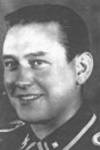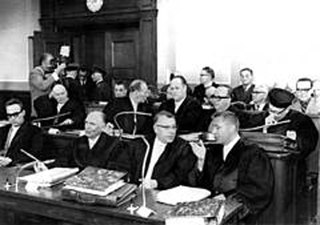
Nazi Germany used six extermination camps, also called death camps, or killing centers, in Eastern Europe during the Holocaust in World War II to systematically murder about 2.7 million Jews during the Holocaust. Others were murdered at the death camps as well, including Poles, homosexuals, Soviet POWs, and Romani. The victims of death camps were primarily killed by gassing, either in permanent installations constructed for this specific purpose, or by means of gas vans. The six extermination camps were Chelmno, Belzec, Sobibor, Treblinka, Majdanek and Auschwitz-Birkenau. Auschwitz and Majdanek death camps also used extreme work under starvation conditions in order to kill their prisoners.

Treblinka was an extermination camp, built and operated by Nazi Germany in occupied Poland during World War II. It was in a forest north-east of Warsaw, 4 kilometres (2.5 mi) south of the village of Treblinka in what is now the Masovian Voivodeship. The camp operated between 23 July 1942 and 19 October 1943 as part of Operation Reinhard, the deadliest phase of the Final Solution. During this time, it is estimated that between 700,000 and 900,000 Jews were killed in its gas chambers, along with 2,000 Romani people. More Jews were killed at Treblinka than at any other Nazi extermination camp apart from Auschwitz.

Bełżec was a Nazi German extermination camp built by the SS for the purpose of implementing the secretive Operation Reinhard, the plan to eradicate Polish Jewry, a key part of the "Final Solution" which entailed the murder of some 6 million Jews in the Holocaust. The camp operated from 17 March 1942 to the end of June 1943. It was situated about 500 m (1,600 ft) south of the local railroad station of Bełżec, in the new Distrikt Lublin of the semi-colonial General Government territory of German-occupied Poland. The burning of exhumed corpses on five open-air grids and bone crushing continued until March 1943.

Sonderkommandos were work units made up of German Nazi death camp prisoners. They were composed of prisoners, usually Jews, who were forced, on threat of their own deaths, to aid with the disposal of gas chamber victims during the Holocaust. The death-camp Sonderkommandos, who were always inmates, were unrelated to the SS-Sonderkommandos which were ad hoc units formed from various SS offices between 1938 and 1945.

John Demjanjuk was a Ukrainian-American accused of war crimes and crimes against humanity carried out while serving as a guard at Nazi extermination camps during World War II. Legal cases concerning his participation in the Holocaust began during the 1970s and continued until his death in 2012. During that time, Demjanjuk's trials attracted global media attention.

Operation Reinhard or Operation Reinhardt was the codename of the secretive German plan in World War II to exterminate Jewish Poles in the General Government district of German-occupied Poland. This deadliest phase of the Holocaust was marked by the introduction of extermination camps.

Sobibor was an extermination camp built and operated by Nazi Germany as part of Operation Reinhard. It was located in the forest near the village of Sobibór in the General Government region of German-occupied Poland.

Majdanek was a Nazi concentration and extermination camp built and operated by the SS on the outskirts of the city of Lublin during the German occupation of Poland in World War II. It had seven gas chambers, two wooden gallows, and some 227 structures in all, placing it among the largest of Nazi-run concentration camps. Although initially purposed for forced labor rather than extermination, the camp was used to kill people on an industrial scale during Operation Reinhard, the German plan to murder all Jews within their own General Government territory of Poland. The camp, which operated from October 1, 1941, until July 22, 1944, was captured nearly intact, because the rapid advance of the Soviet Red Army during Operation Bagration prevented the SS from destroying most of its infrastructure, and the inept Deputy Camp Commandant Anton Thernes failed in his task of removing incriminating evidence of war crimes.

Sobibór is a village in the administrative district of Gmina Włodawa, within Włodawa County, Lublin Voivodeship, in eastern Poland. It lies close to the Bug River, which forms the border with Belarus and Ukraine.

Escape from Sobibor is a 1987 British television film which aired on ITV and CBS. It is the story of the mass escape from the German extermination camp at Sobibor, the most successful uprising by Jewish prisoners of German extermination camps. The film was directed by Jack Gold and shot in Avala, Yugoslavia. The full 176-minute version shown in the UK on 10 May 1987 was pre-empted by a 143-minute version shown in the United States on 12 April 1987.

Thomas "Toivi" Blatt was a Jewish-American Holocaust survivor, writer of mémoires, and public speaker, who at the age of 16 escaped from the Sobibór extermination camp during the uprising staged by the Jewish prisoners in October 1943. The escape was attempted by about 300 inmates, many of whom were recaptured and killed by the German search squads. Following World War II Blatt lived in the Soviet-controlled Poland until the Polish October revolution. In 1957, he emigrated to Israel, and in 1958 settled in the United States.

Karl August Wilhelm Frenzel was an SS non-commissioned officer in Sobibór extermination camp. After World War II, he was convicted and sentenced to life imprisonment for war crimes, but was ultimately released, having served 16 years in prison.

Alexander 'Sasha' Pechersky was one of the organizers, and the leader, of the most successful uprising and mass-escape of Jews from a Nazi extermination camp during World War II; which occurred at the Sobibor extermination camp on 14 October 1943.

Heinz Kurt Bolender was a SS commander during the Nazi era. In 1942, he operated the gas chambers at Sobibór extermination camp, perpetrating acts of genocide against Jews and Romani people during Operation Reinhard. After the war, Bolender was recognized in 1961 while working under a false identity as a doorman at a nightclub in Germany, and subsequently accused in 1965 of personally murdering at least 360 Jewish inmates and assisting in the murder of 86,000 more at Sobibór. He committed suicide in prison two months prior to the end of the trial.

Selma Engel-Wijnberg was one of only two Dutch Jewish Holocaust survivors of the Sobibor extermination camp. She escaped during the 1943 uprising, hid in Poland, and survived the war. Engel-Wijnberg immigrated to the United States from Israel with her family in 1957, settling in Branford, Connecticut. She returned to Europe again only to testify against the war criminals of Sobibor. In 2010 she was in the Netherlands to receive the governmental honor of Knight in the Order of Oranje-Nassau.

The Sobibor trial was a judicial trial directly concerning the Sobibor extermination camp personnel. The trial was held in 1965–66 in Hagen, West Germany. It was one of a series of similar war crime trials held during the early 1960s, such as the Jerusalem Adolf Eichmann trial of 1961 and the Frankfurt Auschwitz Trials of 1963–65, as a result of which the general public came to realize the extent of the crimes that some twenty years earlier had been perpetrated in occupied Poland by Nazi bureaucrats and their executioners. In the same and in subsequent years, separate trials dealt with personnel of the Belzec (1963–65), Treblinka (1964–65), and Majdanek (1975–81) extermination camps.

The Majdanek State Museum is a memorial museum and education centre founded in the fall of 1944 on the grounds of the Nazi Germany Majdanek death camp located in Lublin, Poland. It was the first museum of its kind in the world, devoted entirely to the memory of atrocities committed in the network of slave-labor camps and subcamps of KL Lublin during World War II. The museum performs several tasks including scholarly research into the Holocaust in Poland. It houses a permanent collection of rare artifacts, archival photographs, and testimony.

The Sobibór Museum or the Museum of the Former Sobibór Nazi Death Camp, is a Polish state-owned museum devoted to remembering the atrocities committed at the former Sobibor extermination camp located on the outskirts of Sobibór near Lublin. The Nazi German death camp was set up in occupied Poland during World War II, as part of the Jewish extermination program known as the Operation Reinhard, which marked the most deadly phase of the Holocaust in Poland. The camp was run by the SS Sonderkommando Sobibor headed by Franz Stangl. The number of Jews from Poland and elsewhere who were gassed and cremated there between April 1942 and October 14, 1943 is estimated at 250,000; possibly more, including those who came from other Reich-occupied countries.

Stanisław "Szlomo" Szmajzner was one of 47 known survivors of the Sobibór extermination camp in German-occupied Poland and participated in the 1943 camp-wide revolt and escape from Sobibór.


















